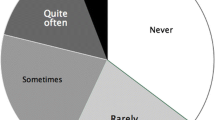Abstract
Food satiation and oral hygiene punishment were used to treat the non-lifethreatening rumination of two institutionalized profoundly retarded persons. Satiation consisted of allowing the clients to eat until a satiation criterion of food refusal was achieved or until two full meal portions were consumed. The oral hygiene procedure consisted of cleansing the clients' teeth and gums with Listerine for 2 minutes following each instance of rumination. In the formal study, three conditions—baseline, satiation, and satiation plus oral hygiene—were used following the lunch meal in a multiple-baseline across-subjects design. One client's rumination decreased from an average of 89.5% during baseline to 48.8% during the satiation condition and to 3% during satiation plus oral hygiene. The second client's rumination decreased from a baseline average of 49.9% to 7.9% during satiation and to 1.4% during satiation plus oral hygiene. Generalization probes taken following the breakfast and dinner meals showed a systematic decline in rumination as the various conditions were implemented following the lunch meal. In the 16-week follow-up, rumination was treated following all meals with oral hygiene, and satiation was used at one of the daily meals for 1 week on a rotating basis. Rumination remained at a near-zero level following all meals throughout the follow-up. Thereafter, a maintenance program was conducted by the ward staff. The satiation plus oral hygiene punishment treatment program appears to be an immediate, effective, enduring, and humane method of treating the non-life-threatening rumination of retarded individuals.
Similar content being viewed by others
References
Alford, G. S., Blanchard, E. B., & Buckley, T. M. Treatment of hysterical vomiting by modification of social contingencies: A case study.Journal of Behavior Therapy and Experimental Psychiatry, 1972,3, 209–212.
Becker, J. V., Turner, S. M., & Sajwaj, T. E. Multiple behavioral effects of the use of lemon juice with a ruminating toddler-age child.Behavior Modification, 1978,2, 267–278.
Bright, G., & Whaley, D. L. Suppression of regurgitation and rumination with aversive events.Michigan Department of Mental Health Bulletin, 1968,2, 17–20.
Cunningham, C. E., & Linscheid, T. R. Elimination of chronic infant ruminating by electric shock.Behavior Therapy, 1976,7, 231–234.
Ferster, C. B., & Skinner, B. F.Schedules of reinforcement. New York: Appleton-Century-Crofts, 1957.
Findley, J. D. An experimental outline for building and exploring multi-operant behavior repertoires.Journal of the Experimental Analysis of Behavior, 1962,11, 703–710.
Foxx, R. M. Developing overcorrection procedures for problem behaviors: A strategy for individualizing treatment programs.Eighth Annual Conference of the National Society for Autistic Children, 1976, 102–134. (a)
Foxx, R. M. The use of overcorrection to eliminate the public disrobing (stripping) of retarded women.Behaviour Research and Therapy, 1976,14, 53–61. (b)
Foxx, R. M., & Azrin, N. H. Restitution: A method of eliminating aggressive-disruptive behavior of mentally retarded and brain damaged patients.Behaviour Research and Therapy, 1972,10, 15–27.
Foxx, R. M., & Azrin, N. H. The elimination of autistic self-stimulatory behavior by overcorrection.Journal of Applied Behavior Analysis, 1973,6, 1–14.
Foxx, R. M., & Martin, E. D. Overcorrection as an effective treatment of the scavenging behaviors of coprophagy and pica.Behaviour Research and Therapy, 1975,13, 153–162.
Galbraith, M. D., Byrick, R. J., & Rutledge, J. T. An aversive conditioning approach to the inhibition of chronic vomiting.Canadian Psychiatric Association Journal, 1970,15, 311–313.
Jackson, G. M., Johnson, C. R., Ackron, G. S., & Crowley, R. Food satiation as a procedure to decelerate vomiting.American Journal of Mental Deficiency, 1975,80, 223–227.
Kanner, L.Child psychiatry (3rd ed.). Springfield, Illinois: Charles C Thomas, 1957.
Kohlenberg, R. J. The punishment of persistent vomiting: A case study.Journal of Applied Behavior Analysis, 1970,3, 241–245.
Lang, P. J., & Melamed, B. G. Avoidance conditioning therapy of an infant with chronic ruminative vomiting.Journal of Abnormal Psychology, 1969,74(1), 1–8.
Luckey, B. S., Watson, C. M., & Musick, J. K. Aversive conditioning as a means of inhibiting vomiting and rumination.American Journal of Mental Deficiency, 1968,73, 139–142.
Malott, R. W. The effects of pre-feeding in plain and chained fixed ratio schedules of reinforcement.Psychonomic Science, 1966,4, 285–286.
Sajwaj, T., Libet, J., & Agras, S. Lemon-juice therapy: The control of life-threatening rumination in a six-month-old infant.Journal of Applied Behavior Analysis, 1974,7, 557–563.
Smeets, P. M. Withdrawal of social reinforcers as a means of controlling rumination and regurgitation in a profoundly retarded person.Training School Bulletin, 1970,67, 158–163.
Spergel, S. M. Induced vomiting treatment of acute compulsive vomiting.Journal of Behavior Therapy and Experimental Psychiatry, 1975,6, 85–86.
Toister, R. P., Condron, C. J., Worley, L., & Arthur, D. Faradic therapy of chronic vomiting in infancy: A case study.Journal of Behavior Therapy and Experimental Psychiatry, 1975,6, 55–59.
Whaley, D. L., & Malott, R. W.Elementary principles of behavior. New York: Appleton-Century-Crofts, 1971. Pp. 337–341.
White, J. C., & Taylor, D. J. Noxious conditioning as a treatment for rumination.Mental Retardation, 1967,5, 30–33.
Wolf, M., Birnbrauer, J., Lawler, J., & Williams, T. The operant extinction, reinstatement, and re-extinction of vomiting behavior in a retarded child. In R. Ulrich, T. Statknik, & J. Mabry (Eds.),Control of human behavior: From cure to prevention (Vol. 2). Glenview, Illinois: Scott, Foresman, 1970.
Author information
Authors and Affiliations
Additional information
This article is based, in part, on a thesis submitted by the second author in partial fulfillment of the M.A. degree at the University of Maryland. The authors wish to thank A. C. Catania, Arthur Robin, and Dennis Russo, members of the thesis committee, for their helpful comments. We also wish to thank Dr. James A. Brahlek, head of psychology, Rosewood Center, Owings Mills, Maryland, for his assistance and support. Elie Axelroth, Robert Cuilla, Dianne Ebberts, Sue Glass, and Andrea Rubinoff served as observers during various conditions.
Rights and permissions
About this article
Cite this article
Foxx, R.M., Snyder, M.S. & Schroeder, F. A food satiation and oral hygiene punishment program to suppress chronic rumination by retarded persons. J Autism Dev Disord 9, 399–412 (1979). https://doi.org/10.1007/BF01531447
Issue Date:
DOI: https://doi.org/10.1007/BF01531447




